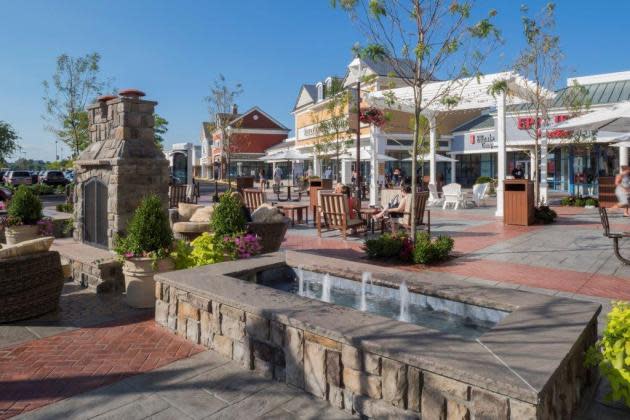ICSC New York: Confronting Rapid Change and Uncertainty

Amid global economic uncertainty and fast-changing shopping patterns, ICSC New York, an annual two-day gathering of hundreds of dealmakers and real estate and retail experts, is back in real life as of Tuesday, at the Javits Center on Manhattan’s West Side.
The event was last held live in 2019 due to COVID-19, but with the rollout of vaccines, there was anticipation and optimism in the air leading up to this year’s gathering. The retail environment has changed too, and many retailers are beyond rationalizing their store portfolios after experiencing bankruptcies and reassessing locations, and renegotiating with landlords for shorter, more favorable leases, and are ready to build back their businesses. Abercrombie & Fitch Co., for example, opened 60 stores and closed about 30 this year, and has similar plans for net openings that will unfold next year. There’s flexibility in negotiations for landlords, with more than 200 A&F Co. leases coming due in 2023.
More from WWD
Other retailers with agendas for store openings are Macy’s Inc. with its new Market by Macy’s and Bloomies specialty formats, and Target, which has a larger format for future locations to enhance same-day delivery and order fulfillment. Others opening stores include Rue21, Madewell, Von Maur and Athleta. But no one is opening as many stores as Dollar General, which plans more than 1,000 in 2023. There’s even some buzz about Amazon opening a department store.
Among the hundreds of exhibitors at ICSC: American Dream, the mega retail and entertainment complex that after initial difficulties continues to attract tenants, most recently Apple; DoorDash, a crucial delivery partner to many retailers building omni capabilities; Gordon Brothers, which has a growing portfolio of brands and investments and last month invested $25 million in Everlane; and several major developers, including Macerich, Tanger Factory Outlet Centers and Unibail-Rodamco-Westfield.
On the development front, Simon Property Group is in the advanced stages of a multiphase expansion of its world-famous Woodbury Common Premium Outlets. Simon is also moving forward on a 400,000-square-foot high-end fashion outlet and value center in the City of Carson in California, and on an outlet center in Nashville, in partnership with locally based Adventurous Journeys Capital Partners. Tanger is planning an outlet center in Nashville as well, while adding new tenants to its mix such as Wolford and Allbirds, while Macerich is reinvesting in its Scottsdale Fashion Square in Arizona with an extensive interior and exterior renovation of its luxury wing, currently the healthiest sector of retailing and least impacted by inflation.

“Developers are closely watching the economy as inflation persists and could impact new projects,” Tom McGee, ICSC’s president and chief executive officer, told WWD ahead of the event. “Additionally, they are concerned about the tight labor market and the lack of people choosing to learn trade jobs such as construction, which creates delays and adds costs to new developments.
“For retailers, the biggest issue is understanding how to best meet the needs of the consumer in the current — and shifting — economic conditions. As things like inflation, interest rate hikes, and other factors squeeze consumers’ wallets, retailers are evaluating how they can maximize their online and in-store channels in order to provide value to the consumer while also protecting the bottom line,” he continued.
“Many in our industry feel they’ve weathered the storm of the last few years and are focused on the future,” he said.
He said this year’s event offers a variety of programs during the conference, including micro-learning sessions, moderated panel discussions, and a fireside chat with Hoyt Jones, president of Jersey Mike’s, with conversations on diversity and inclusion in marketplaces, the role of retail in major cities and more.
Presentations and private conversations at ICSC, aside from the dealmaking, also focused on adding services, conveniences and alternative uses to shopping venues, furthering the intersection of physical and online shopping, adjusting to fast-changing shopping patterns, resurrecting downtowns and avoiding the pitfalls of dividing up big-box stores into junior tenants. According to McGee, more than 7,000 attendees were expected for the event.
Asked if this year’s surge of consumers returning to stores is sustainable, or could be a knee-jerk reaction to so much shopping online and being cooped up at home during the pandemic, McGee replied: “The influx of shoppers we are seeing choose brick-and-mortar retail is very much sustainable. Human beings naturally crave in-person interaction and the experience of shopping in a store, going to a restaurant and other forms of entertainment. Throughout the pandemic, consumers widely turned to online shopping or curbside pickup to get the items they wanted and needed, but as we revert to pre-pandemic behaviors, consumers are returning to in-store shopping for the experience they cannot get online. Retailers who are successful have a fully integrated online and offline model that flows seamlessly to put the customer experience first. Omnichannel avenues have proven to be crucial to giving shoppers what they need from both online and physical retail.”
Around the country, McGee said there is “a lot of redevelopment happen[ing] that is focused on creating an urban feel in a suburban environment. That allows consumers to live, work and play in a consolidated area where they might not even need a car to meet all their needs.
“Like almost every other industry, retail is constantly evolving to meet the demands and needs of consumers,” McGee added. “While recent years have seen a push towards online shopping, we’ve seen physical stores adapt to the changing behaviors of customers through technology, store layouts, purchasing options and more. The increased use of QR codes and AI technology has been implemented to assist shoppers from inventory check to sizing options. We’ve also recently seen some major retailers experiment with store layouts to accommodate the need for fulfillment space. Buy online, pick up in store has also grown popular in recent years, bridging the gap for online and in-person shopping.”
This year, he said, nationally, the occupancy rate at shopping centers of all types, which he refers to as marketplaces, is 91.7 percent. “There aren’t many vacancies to fill. That said, this year we have seen a large number of restaurants and value stores announce new stores being opened, 1,153 and 2,065, respectively. But there has been strong interest from retailers across all sectors in opening stores, with nearly 5,000 new locations being announced.
“Overall, the outlook is positive for the industry, and shopping centers have performed well,” McGee said. “Foot traffic has rebounded back to pre-pandemic levels, delinquency rates have fallen significantly from their high in the pandemic, and occupancy rates are high. While we’re cognizant of economic uncertainty and global headwinds, consumers are still spending and retailers are demonstrating continued resilience despite inflation and other obstacles. We expect 2023 to be a strong year across the marketplaces industry, as retailers, retail real estate leaders and investors continue finding new and creative ways to meet consumer needs and drive our industry forward.”
ICSC surveyed a demographically representative U.S. sample of 1,005 and 1,008 individuals online Nov. 25 and Nov. 28, respectively, and based on the research, came up with some conclusions supporting assumptions that brick-and-mortar stores are performing OK so far for holiday 2022.
According to the surveys, 66 percent of holiday weekend shoppers — approximately 119.7 million adults — spent money at a physical store over the holiday weekend, up 5 percent from last year. Shoppers cited the ability to physically see or touch merchandise (50 percent), browsing for new gift ideas (35 percent) and an overall preference for in-store shopping (34 percent) as primary motivations for visiting a store. Nearly half (48 percent) made purchases from Amazon or other pure-play online retailers. Of those who shopped online, the largest segment (63 percent) cited convenience, while half cited cheaper prices or better promotions. Overall, 73 percent of Thanksgiving Weekend shoppers visited a shopping center during the long weekend to shop or for other activities and services.
“The early start to the shopping season didn’t stop people from shopping on Black Friday and throughout the holiday weekend, including Cyber Monday — and consumers indicated they still have more shopping to do,” said McGee. “Discount department stores saw particularly strong traffic, and in-store shopping overall was positive as deals extended across the [Thanksgiving] weekend. Not surprisingly, shoppers are seeking the best prices and deals and seem willing to wait until they can find them.”

